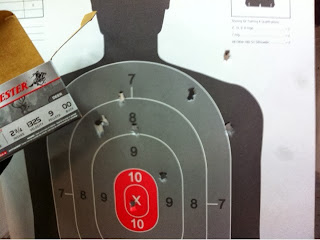Guns: FN SLP review (Standard model) - The Belgian Bruiser

Introduction
I've owned half a dozen pump shotguns in my lifetime (including an old 870 and a new 500), but until the FN SLP came along, I had never owned an autoloader. I suppose the only reason for that was my prejudices, built up from years of gun magazines and firearms forums. After all, semiautomatic shotguns were more expensive, sensitive to different loads, and not practically faster to operate than a pump, right?
Well, it's always dangerous to go through life with no hard evidence. When a very lightly used FN SLP came on sale at RRPSI Firearms for $800, I decided to put my prejudices to the test...
First Impressions
The SLP standard is smaller and lighter than I expected it to be. Lengthwise, it's extremely close to an 18" barreled pump action Remington 870/ Mossberg 500 (38.75" vs. 38.5"), and it's only about a pound heavier. Most of the additional weight is in the receiver, too, so the gun balances fairly well.
FN has a pretty good reputation in the gun community, and the SLP is obviously well made and well fitted. You can tell that the gun was made to take a beating. The all-black finish is tough, and the bore is hard chromed.
Sights and Controls
The standard SLP comes equipped with robust fixed ghost ring sights, adjustable for both windage and elevation. The front post is attached to the barrel and protected by M16-like wings, while the rear is clamped onto the receiver-mounted Picatinny rail (which can also be used for a red dot).
The trigger is a fairly standard single-stage, with a crossbolt push-button safety. The bolt release latch is also a push-button, located forward of the ejection port near the charging handle. I have small hands, and both the bolt release and charging handle are too small even for me. I'm also not a fan of the layout - the position of the release makes it possible for someone to interfere with the bolt going forward, if they're not careful with their hand placement.
Operation, Disassembly, Accessories
The FN SLP is gas-operated, introducing an additional layer of complexity not present in a pump. Oh, the gun is easy enough to disassemble, with a fairly logical spring system and two different pistons (light and heavy), but the added components are just another thing to wear down and break.
A word of warning: I recommend staying with the "light" piston unless you're exclusively shooting 3" shells. The "heavy" piston doesn't give the system enough gas with typical 12 gauge loads. For instance, the Winchester buckshot pictured below cycled fine with the light piston, but did not cycle at all with the heavy one.

Variants
The SLP comes in four flavors: the "Standard," the "Tactical" (pistol grip stock and tube-mounted accessory rail), the "Mk1" (22" barrel, 8-shell capacity, cantilever optics mount with folding sight), and the "Mk1 Tactical" (a Mk1 with the Tactical accessories).
For self-defense, the Standard and Tactical 18" barreled models are my pick, as they're shorter, handier, and still hold 6 shells in the tube. If you're planning on shooting in competition, though, go with either of the Mk1 versions - the extra barrel length and capacity are essential, and the cantilever mount allows you to keep an optic mated with the barrel it's zeroed for.
Range Report
I patterned the gun with various 00 buckshot loads at 15 yards, using the improved cylinder choke tube. As you can see below, basically all the patterns came in at about ~15" in diameter. I wish the patterns were tighter (every missed pellet is a liability), but they're about par for an 18" barrel factory 12 gauge, and they're not big enough to be worrisome.
Remington Express 00 buckshot:
5 shells' worth of Remington Express, fired as rapidly as I could (my point of aim drifted up a little). I didn't have a timer, but it was obvious that the SLP was much faster with repeated shots on a single target than a pump, at least in my hands (I can rack a pump fast enough to hit doubles in skeet, but I'm still faster with the SLP than I am with my 870 ). I can't imagine any real-world scenario where I'd have to empty this much lead into one place, but you never know:
Winchester military buckshot:
Estate buckshot (hole in the upper left is not part of the pattern):
Spartan buckshot (overall, the best value for the money - great load to stock up on):
Winchester commercial buckshot:
Slug accuracy was good, though I didn't have enough loads on hand to do a comprehensive test. Here's five Remington "Slugger" shells at 25 yards, offhand:
Final Thoughts
Notwithstanding my preference for pumps, I found my FN SLP to be tough, reliable (with the light piston), and easy to shoot. There's also a good amount of accessories and aftermarket parts available for the gun, thanks to its popularity in practical shooting competitions. While I wasn't fond of the controls, they didn't really hamper my shooting, and I could easily get the hits I needed to with the SLP, weird bolt release placement and all. So, if you're in the market for a 12 gauge autoloader, it's hard to go wrong with the FN SLP.








